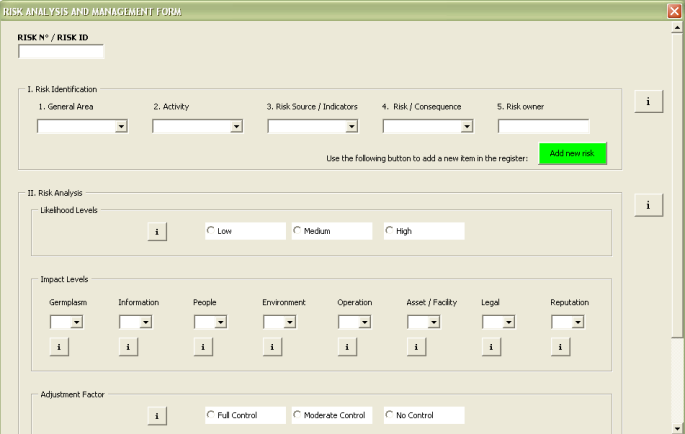Risk identification and analysis
The topic is updated by Abdul Sattar Khan Kulachi.
Click on the image above for the generic risk assessment tool for
seed crops |
Click on the image above for the generic risk assessment tool for clonal crops
|
Taking into account information gathered in Risk assessment, an inventory of relevant risks to the genebank operations should be made. The major risks to genebanks are germplasm mis-identification, unstable storage facilities and insufficient funding support. An extensive list of risks gathered in documents from five CGIAR Centers and genebank of the Philippine Rice Research Institute, discussions with four USDA-ARS conservation and database management sites and information contained in various genebank management literature has been compiled and is set out in Table 1 for seeds and Table 2 for clonal materials.
The generic risk assessment tool for seed crops and clonal crops serves as the input forms for risks and other information required for a particular genebank. For this step, the general area of genebank operations and specific activity and the risk source/indicator should be identified. These can be selected from those listed in Table 1a and Table 2a, but need not be limited to these.
Also, as part of the risk identification step, risk ownership should be identified. This means identifying the organizational unit or manager who is responsible for monitoring, analyzing, evaluating the risk and implementing the controls or contingency plans associated with the risk. Most of the risks identified will be managed by managers and staff within the genebank or larger Genetic Resources Unit (or equivalent) in which the genebank staff are organizationally located. Others will be managed in partnership with other units within the Centres. The suggested partner units are identified in Table 1b and Table 2b.
Risk analysis covers both the potential impact (or consequence) of the identified risks, and their likelihood (probability). In the case of likelihood, an intrinsic likelihood was first considered, taking into account the nature of the risk and its probability in the absence of controls or other mitigations, and then adjusted for mitigating controls that were confirmed as being in place. To develop a quantitative risk assessment, a point system for the scales or levels of the likelihood and impact of risks was devised in the context of genebanking operations. The point system was simplified and, consistent with the approach taken by many CGIAR Centres for their enterprise wide risk management frameworks; a 3-point scale was proposed: 1 point (Low), 2 points (Medium), and 3 points (High) for both likelihood and impact.
Intrinsic likelihood
The likelihood levels table below provides suggested definitions for the likelihood scale. These likelihood levels can be amended to suit a particular genebank’s conditions. Should a genebank wish to initially simplify this further, a 2-point scale could be adopted: 1 point (Low) and 2 points (High) for both likelihood and impact.
Likelihood levels
Low (1)
|
Very unlikely to practically impossible; 0-10% of the time. (Example: one or no occurrence in ten years.)
|
Medium (2)
|
Occasional; 20-60% of the time. (Example: two or six occurrences in ten years.)
|
High (3)
|
Moderately frequent to frequent; Above 60% of the time. (Example: seven and more occurrences in ten years.)
|
Impact
Since risks can impact multiple aspects of genebanking, namely: germplasm, information, people, environment, asset/facility, operations, legal and reputation; quantitative cut-offs can be set for each area. For initial implementation, to keep the process simpler, impact of legal and reputation risks may be excluded. Table 3 sets out suggested definitions for the impact levels taking into account these multiple aspects. There will be risks that impact multiple aspects per category. The highest risk level in any aspect should be the one selected for each category.
Example 1: For category germplasm, a certain risk poses high (3) impact on viability, medium (2) on diversity and low (1) on availability, then the score for this category is 3. However, if at least two of the aspects have medium (2) impact, then the category as a whole gets the highest (3) score for impact.
For regular implementation of this rating scheme, low is loss of seed viability by 0-1%, medium by 2-5% and high by above 5% per year. For an initial, simpler implementation, low could be loss of seed viability by 0-1%, and high could be loss by more than 1% per year.
The total impact score can then be the sum of the scores in all the aspects considered. Note that 1 point should be given to any of the above mentioned aspects that are not affected by the risk as a normalization step for computing for relative weights of the risks.
|
One suggested rating scheme, taking account of the multiple aspects reflected in Table 3, is to award an overall Low impact rating where there is an aggregate total of 8 points, a Medium rating where this a total of 9 points (with 2 points in at least one area) and a High rating where this is a total of 10 points (with 3 points in at least one area) under High impact. Hence, risks with an impact score of 2 points each (Medium) in two or more areas will have a total greater than 9 points and subsequently fall under High impact.
Example 2: If the risk indicator is “Misidentification of germplasm” during collecting, the impact may be assessed in the various categories from germplasm to reputation using the generic risk assessment tool for seed crops and clonal crops, as follows:

Germplasm – 3, if the misidentified germplasm is in terms of diversity “recoverable from only 1 to 3 sources to total loss.” This can happen if the material is grown only in one location that is undergoing conversion or becoming inaccessible.
Information – 2, if this risk indicator results in “6-10% gap in data or 6-10% loss in data accuracy or 30-90% usefulness”.
People, Environment, Operation, Asset/Facility, Legal and Reputation - 1, since this risk source does not affect any aspect in these categories.
In this case the total score comes to 11, and so the risk is rated “High” impact.
The above rating scheme can be changed to more accurately reflect local conditions and standards.
|
Adjustment Factor
Existing controls or strategies to mitigate the risks were identified and described. These controls or other mitigations can be in three areas: personnel; facility and equipment; and procedure/methodology. The areas of control table below provides further information on these three areas.
Areas of control
Personnel
|
Staff performing the activity receives competency through training or actual experience. Dedication and enthusiasm through adequate compensation.
|
Facility and
Equipment |
Machine or equipment used is of correct specification, capability and good condition, and is available.
|
Procedure
|
Appropriate procedure developed and communicated on conduct of activity.
|
Table 1c and Table 2c provide examples of controls, classified according to these three areas, for the risks listed in the tables. As illustrated in these Tables, there are risks that need controls in all three areas, while some risks can be addressed in only one or two areas.
The documented references to these controls should be linked to the supporting documents such as policies and procedures, and the evidence(s)/proof(s) that the control measures described are being implemented should be checked through analysis of operating measurements and periodic audits.
Based on adequacy of controls, the risk likelihood rating may be adjusted. The adjustment factor table below presents a scheme for this purpose. For a more simple, initial adoption, Moderate to Full control, worth 1 point, means there are existing controls in at least one of all applicable areas during the time of risk assessment. No control, worth 2 points, indicates there is no mitigation at all.
Adjustment factor
Rating
|
Points
|
Description
|
Full Control
| 1 |
Consistent control in all applicable areas
|
Moderate Control
| 2 |
Existing controls in one or two areas during the time of risk assessment
|
No Control
| 3 |
No control at all during the time of risk assessment
|
Total Risk Rating
The total level of risk (risk rating) is determined by the product of the ratings for impact, intrinsic likelihood and the adjustment factor to reflect the contribution of existing controls or other mitigating factors to decrease the level of risk. The products of all the combinations of likelihood, impact and control levels are in given the table for the total risk rating below. The ultimate goal is to have full control in order to reduce the total risk rating to Low Risk wherever possible, while acknowledging that some external risks may only be addressed by contingency plans.
Total risk rating
Total Impact
| ||||||
Low (8)
|
Medium (9)
|
High (10)
| ||||
Intrinsic likelihood
|
8
|
9
|
10
|
Full (1)
|
Control
| |
Low (1)
|
16
|
18
|
20
|
Partial (2)
| ||
24
|
27
|
30
|
No (3)
| |||
16
|
18
|
20
|
Full (1)
| |||
Medium (2)
|
32
|
36
|
40
|
Partial (2)
| ||
48
|
54
|
60
|
No (3)
| |||
24
|
27
|
30
|
Full (1)
| |||
High (3)
|
48
|
54
|
60
|
Partial (2)
| ||
72
|
81
|
90
|
No (3)
| |||
Low Risk: 8 - 27 points (scores in blue cells)
Medium Risk: 28 – 54 points (scores in yellow cells)
High Risk: > 54 points (scores in red cells)
Medium Risk: 28 – 54 points (scores in yellow cells)
High Risk: > 54 points (scores in red cells)







0 comments:
Post a Comment